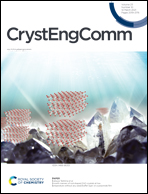Growth manner of rod-shaped ZnO crystals at low temperature without any seed/buffer layer on a polyimide film†
Abstract
ZnO is widely used as a semiconductor material in a variety of applications. Usually, ZnO is used as a thin film, which is composed of ZnO/intermediate layers/substrates. Recently we developed a rod-shaped ZnO crystal layer directly on a polyimide film without any intermediate layers by solution reaction coupled with surface treatments of the film. We studied the growth mechanism of ZnO crystal layers on the polyimide surface in the solution process. The physical and chemical effects of alkali, plasma, and heating treatments were clarified. The results indicated formation of homogeneous, fine irregularities on the polyimide surface and predominance of imide groups. The direct growth of ZnO crystals is attributed to the anchoring effect derived from gradual nuclei growth of Zn(OH)2 in the homogeneous, fine irregularities of the polyimide film. We also demonstrated a more facile approach for the preparation of ZnO crystal layers by physical roughening of the polyimide film to verify our proposed mechanism. Our findings provide new insights into the growth of ZnO crystals on polyimide and other polymer substrate surfaces without the use of any intermediate layer. This knowledge may be further used for mass production of ZnO crystals/polyimide thin films at low cost.

- This article is part of the themed collection: Crystal Engineering Techniques


 Please wait while we load your content...
Please wait while we load your content...
